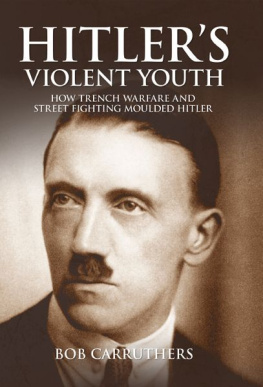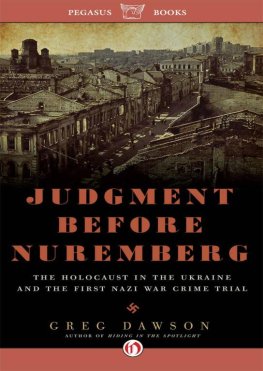

This edition published in 2014 by
Pen & Sword Military
An imprint of
Pen & Sword Books Ltd
47 Church Street
Barnsley
South Yorkshire
S70 2AS
First published in Great Britain in 2013 by Coda Books Ltd.
Copyright Coda Books Ltd.
Published under licence by Pen & Sword Books Ltd.
ISBN: 9781783463190
eISBN: 9781473849433
A CIP catalogue record for this book is available from the British Library
All rights reserved. No part of this book may be reproduced or transmitted in any form or by any means, electronic or mechanical including photocopying, recording or by any information storage and retrieval system, without permission from the Publisher in writing.
This book includes excerpts from The Trial of German Major War Criminals Proceedings of the International Military Tribunal Sitting at Nuremberg, Germany published under the authority of H.M. Attorney-General by His Majestys Stationery Office, London 1946/1947.
Printed and bound in England
By CPI Group (UK) Ltd, Croydon, CR0 4YY
Pen & Sword Books Ltd incorporates the imprints of Pen & Sword Aviation, Pen & Sword Family History, Pen & Sword Maritime, Pen & Sword Military, Pen & Sword Discovery, Pen & Sword Politics, Pen & Sword Atlas, Pen & Sword Archaeology, Wharncliffe Local History, Wharncliffe True Crime, Wharncliffe Transport, Pen & Sword Select, Pen & Sword Military Classics, Leo Cooper, The Praetorian Press, Claymore Press, Remember When, Seaforth Publishing and Frontline Publishing
For a complete list of Pen & Sword titles please contact
PEN & SWORD BOOKS LIMITED
47 Church Street, Barnsley, South Yorkshire, S70 2AS, England
E-mail: enquiries@pen-and-sword.co.uk
Website: www.pen-and-sword.co.uk
Foreword
T he Nuremberg Trials were held by the four victorious Allied forces in the Palace of Justice, Nuremberg from November 1945 to October 1946. Famous for prosecuting the major German war criminals, they also tried the various groups and organisations that were at the heart of Nazi Germany.
There were four counts against the accused:
- Count One: The Common Plan or Conspiracy
- Count Two: Crimes against Peace
- Count Three: War Crimes
- Count Four: Crimes against Humanity
The Rt. Hon. Sir Geoffrey Lawrence of Great Britain was the President of the court, and the United States of America, France, the United Kingdom, and the Union of Soviet Socialist Republics each provided one judge and an alternate, as well as a prosecutor and their assistants. Each defendant was given counsel, the majority of whom were German, along with a team of assistants, clerks and lawyers.
This volume is concerned with the trial of the Gestapo and includes all testimony regarding this organisation, and because of the close structural ties between the two groups, also includes some evidence regarding the S.D. (Der Sicherheitsdienst) and the defendant Ernst Kaltenbrunner, who was Obergruppenfhrer and General der Polizei und Waffen-SS. The defense counsel were as follows:
- Dr. Rudolf Merkel, Counsel for the Gestapo
- Ludwig Babel, Counsel for the SS and SD to 18th March 1946
- Dr Hans Gawlik, Counsel for the SD from 18th March 1946.
- Dr. Kurt Kauffmann, Counsel for Ernst Kaltenbrunner.
The witnesses called for the trial of the Gestapo and the SD include among others, Karl Hoffmann, Dr. Werner Best, Rolf-Heinz Hoeppner, Dieter Wisliceny and Walter Schellenberg
Karl Hoffmann was a senior Gestapo official who served in Koblenz and Dusseldorf, and was head of the Gestapo in Denmark from 1943. He was sentenced to death in 1948 in Copenhagen, but his sentence was transmuted to 20 years in prison. In 1952, however, he was released and deported to West Germany, where he worked as a lawyer. He died in 1975.
Dr. Werner Best (1903-1989) was a German lawyer and senior Nazi. Prior to the outbreak of the war, he was head of Department 1 of the Gestapo and oversaw organisation, administration, and legal affairs. Both Himmler and Heydrich relied on Best to develop the legalities of their actions against the enemies of the state and the Jewish problem. In 1942, he became the Third Reichs Plenipotentiary in Denmark and supervised civilian affairs there. In 1948, he was sentenced to death by a Danish court, but this sentence was reduced to twelve years, and then he was released in 1951. He was charged in 1972 after more war crimes allegations became uncovered, but he was found unfit to stand trial and released.

VICTIMS OF THE GESTAPO.
Row 1, left to right: Bruno Schulz (1892-1942), Polish writer. Denise Bloch (19161945), French SOE agent. Edward Hamerski (1897-1941), Polish physician. Stanisaw Mczewski (1892-1941), Polish physician. Violette Szabo (1921-1945), French SOE agent
Row 2, left to right: Jzef Padewski (1894-1951), Polish bishop, imprisoned in 1942. Stanisaw Estreicher (1869-1939), Polish historian. Stanisaw Klimecki (1883-1942), Mayor of Krakow. Zdzisaw Jachimecki (1882-1953), Polish composer, imprisoned in 1939. Ignacy Fik (1904-1942), Polish poet and critic
Row 3, left to right: Noor Inayat Khan (1914-1944), British SOE agent. Marc Bloch (1886-1944), French historian. Wilhelm Gaczek (1881-1941), Polish clergyman. Rudolf Hilferding (1877-1941), Austrian economist. Herschel Grynszpan (1921- declared dead 1960), German political assassin
Row 4, left to right: Julius Fuk (1903-1943), Czech journalist. Wodzimierz Sieradzki (1870-1941), Polish physician. Vladislav Vanura (1891-1942), Czech writer. Eliane Plewman (1917-1944), French SOE agent. Max Jacob (1876-1944), French writer
Row 5, left to right: Mildred Fish-Harnack (1902-1943), American writer. Lilian Rolfe (19141945), British SOE agent. Antoni omnicki (1881-1941), Polish mathematician. Adolf Reichwein (1898-1944), German educator. Hilde Coppi (1909-1943), German resistance fighter
Rolf-Heinz Hoeppner became a member of the SD in 1934 and was an SS-Obersturmbannfhrer in the Reich Security Main Office (RSHA). He was head of the Central Resettlement Office in Posen and responsible for the deportation of Jews and Poles and the settlement of ethnic Germans in Wartheland. He was extradited to Poland in 1947, but reports vary as to whether he was executed or released as part of an amnesty in 1957.
Dieter Wisliceny enlisted in the SS in 1934 and rose to SS-Hauptsturmfhrer (captain) by 1944. He took part in the ghettoisation and liquidation of many Jewish communities in Greece, Hungary and Slovakia. His testimony at Nuremberg proved important for Adolf Eichmanns trial in Israel in 1961. Wisliceny was extradited to to Czechoslovakia, where he was tried and hanged in 1948.
Walter Schellenberg was an SS-Brigadefhrer (General) who rose through the ranks to become the head of foreign intelligence in 1944. In 1940, he compiled the Informationsheft G.B., a blueprint for the occupation of Britain, and also intercepted the Duke and Duchess of Windsor in Portugal in an attempt to persuade them to work for the German cause. In 1945, he as able to persuade Himmler to try negotiating with the Western Allies. To foster goodwill Schellenberg organised the transport of 1,700 Jews out of German controlled territory, but Hitler found out and put a stop to further evacuations. Sought after as a valuable intelligence asset by the Allies, Schellenberg was captured by the British in Denmark in June 1945, and he testified against the Nazis in the Nuremberg Trials. In the 1949 Ministries Trial, he was sentenced to six years imprisonment, but was released in 1951 on the grounds of ill-health and he died of cancer in 1952 in Turin.
Next page

















